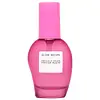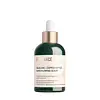Glow Recipe Prickly Pear Peptide Mucin Versus Biossance Squalane + Copper Peptide Rapid Plumping Serum
What's inside
What's inside
 Key Ingredients
Key Ingredients

 Benefits
Benefits

 Ingredients Side-by-side
Ingredients Side-by-side

Opuntia Ficus-Indica Stem Extract
Skin ConditioningPropanediol
SolventButylene Glycol
HumectantWater
Skin ConditioningBetaine
HumectantOpuntia Ficus-Indica Fruit Extract
Skin ConditioningPalmitoyl Tripeptide-1
Skin ConditioningEctoin
Skin ConditioningSodium Hyaluronate
HumectantGlycerin
HumectantUbiquinone
AntioxidantGalactomyces Ferment Filtrate
HumectantBifida Ferment Filtrate
Skin ConditioningSpilanthes Acmella Flower/Leaf/Stem Extract
AntimicrobialCarthamus Tinctorius Seed Oil
MaskingGlycyrrhiza Glabra Root Extract
BleachingChamaecyparis Obtusa Leaf Extract
Skin ConditioningAmmonium Acryloyldimethyltaurate/Vp Copolymer
Paeonia Suffruticosa Root Extract
Skin ProtectingAstragalus Membranaceus Root Extract
EmollientScutellaria Baicalensis Root Extract
AstringentPEG-40 Hydrogenated Castor Oil
Emulsifying1,2-Hexanediol
Skin ConditioningPPG-26-Buteth-26
Skin ConditioningCaprylyl Glycol
EmollientTocopherol
AntioxidantOpuntia Ficus-Indica Stem Extract, Propanediol, Butylene Glycol, Water, Betaine, Opuntia Ficus-Indica Fruit Extract, Palmitoyl Tripeptide-1, Ectoin, Sodium Hyaluronate, Glycerin, Ubiquinone, Galactomyces Ferment Filtrate, Bifida Ferment Filtrate, Spilanthes Acmella Flower/Leaf/Stem Extract, Carthamus Tinctorius Seed Oil, Glycyrrhiza Glabra Root Extract, Chamaecyparis Obtusa Leaf Extract, Ammonium Acryloyldimethyltaurate/Vp Copolymer, Paeonia Suffruticosa Root Extract, Astragalus Membranaceus Root Extract, Scutellaria Baicalensis Root Extract, PEG-40 Hydrogenated Castor Oil, 1,2-Hexanediol, PPG-26-Buteth-26, Caprylyl Glycol, Tocopherol
Water
Skin ConditioningGlycerin
HumectantPropanediol
SolventSqualane
EmollientSodium Hyaluronate
HumectantHydroxyethyl Acrylate/Sodium Acryloyldimethyl Taurate Copolymer
Emulsion StabilisingCopper Tripeptide-1
Skin ConditioningAcmella Oleracea Extract
Skin ProtectingEctoin
Skin ConditioningTetrapeptide-30
Skin ConditioningPalmitoyl Hexapeptide-52
Skin ConditioningCopper PCA
HumectantPanthenol
Skin ConditioningSodium Polyglutamate
HumectantCamellia Sinensis Leaf Extract
AntimicrobialAloe Barbadensis Flower Extract
EmollientPassiflora Incarnata Flower Extract
Skin ConditioningMelia Azadirachta Leaf Extract
Skin ConditioningSolanum Melongena Fruit Extract
Skin ConditioningCurcuma Longa Root Extract
MaskingOcimum Basilicum Flower/Leaf Extract
TonicCoccinia Indica Fruit Extract
Skin ConditioningMelia Azadirachta Flower Extract
Skin ConditioningOcimum Sanctum Leaf Extract
Skin ConditioningCorallina Officinalis Extract
Skin ConditioningPolyacrylate Crosspolymer-6
Emulsion StabilisingAcacia Senegal Gum
MaskingXanthan Gum
EmulsifyingPhenoxyethanol
PreservativeEthylhexylglycerin
Skin ConditioningCitric Acid
BufferingCaprylyl Glycol
EmollientWater, Glycerin, Propanediol, Squalane, Sodium Hyaluronate, Hydroxyethyl Acrylate/Sodium Acryloyldimethyl Taurate Copolymer, Copper Tripeptide-1, Acmella Oleracea Extract, Ectoin, Tetrapeptide-30, Palmitoyl Hexapeptide-52, Copper PCA, Panthenol, Sodium Polyglutamate, Camellia Sinensis Leaf Extract, Aloe Barbadensis Flower Extract, Passiflora Incarnata Flower Extract, Melia Azadirachta Leaf Extract, Solanum Melongena Fruit Extract, Curcuma Longa Root Extract, Ocimum Basilicum Flower/Leaf Extract, Coccinia Indica Fruit Extract, Melia Azadirachta Flower Extract, Ocimum Sanctum Leaf Extract, Corallina Officinalis Extract, Polyacrylate Crosspolymer-6, Acacia Senegal Gum, Xanthan Gum, Phenoxyethanol, Ethylhexylglycerin, Citric Acid, Caprylyl Glycol
 Reviews
Reviews

Ingredients Explained
These ingredients are found in both products.
Ingredients higher up in an ingredient list are typically present in a larger amount.
Caprylyl Glycol is a humectant and emollient, meaning it attracts and preserves moisture.
It is a common ingredient in many products, especially those designed to hydrate skin. The primary benefits are retaining moisture, skin softening, and promoting a healthy skin barrier.
Though Caprylyl Glycol is an alcohol derived from fatty acids, it is not the kind that can dry out skin.
This ingredient is also used as a preservative to extend the life of products. It has slight antimicrobial properties.
Learn more about Caprylyl GlycolEctoin is a compound found naturally in some species of bacteria. It can be synthetically created for skincare use.
This ingredient is an osmolyte; Osmolytes help organisms survive osmotic shock (it protects them from extreme conditions). It does this by influencing the properties of biological fluids within cells.
When applied to the skin, ectoin helps bind water molecules to protect our skin. The water forms a sort of armor for the parts of our skin cells, enzymes, proteins, and more.
Besides this, ectoin has many uses in skincare:
A study from 2004 found ectoin to counteract the damage from UV-A exposure at different cell levels. It has also been shown to protect skin against both UV-A, UV-B rays, infrared light, and visible light.
Studies show ectoin to have dual-action pollution protection: first, it protects our skin from further pollution damage. Second, it helps repair damage from pollution.
In fact, ectoin has been shown to help with:
Fun fact: In the EU, ectoin is used in inhalation medication as an anti-pollution ingredient.
Ectoin is a highly stable ingredient. It has a wide pH range of 1-9. Light, oxygen, and temperature do not affect this ingredient.
Learn more about EctoinGlycerin is already naturally found in your skin. It helps moisturize and protect your skin.
A study from 2016 found glycerin to be more effective as a humectant than AHAs and hyaluronic acid.
As a humectant, it helps the skin stay hydrated by pulling moisture to your skin. The low molecular weight of glycerin allows it to pull moisture into the deeper layers of your skin.
Hydrated skin improves your skin barrier; Your skin barrier helps protect against irritants and bacteria.
Glycerin has also been found to have antimicrobial and antiviral properties. Due to these properties, glycerin is often used in wound and burn treatments.
In cosmetics, glycerin is usually derived from plants such as soybean or palm. However, it can also be sourced from animals, such as tallow or animal fat.
This ingredient is organic, colorless, odorless, and non-toxic.
Glycerin is the name for this ingredient in American English. British English uses Glycerol/Glycerine.
Learn more about GlycerinPropanediol is an all-star ingredient. It softens, hydrates, and smooths the skin.
It’s often used to:
Propanediol is not likely to cause sensitivity and considered safe to use. It is derived from corn or petroleum with a clear color and no scent.
Learn more about PropanediolSodium Hyaluronate is hyaluronic acid's salt form. It is commonly derived from the sodium salt of hyaluronic acid.
Like hyaluronic acid, it is great at holding water and acts as a humectant. This makes it a great skin hydrating ingredient.
Sodium Hyaluronate is naturally occurring in our bodies and is mostly found in eye fluid and joints.
These are some other common types of Hyaluronic Acid:
Learn more about Sodium HyaluronateWater. It's the most common cosmetic ingredient of all. You'll usually see it at the top of ingredient lists, meaning that it makes up the largest part of the product.
So why is it so popular? Water most often acts as a solvent - this means that it helps dissolve other ingredients into the formulation.
You'll also recognize water as that liquid we all need to stay alive. If you see this, drink a glass of water. Stay hydrated!
Learn more about Water